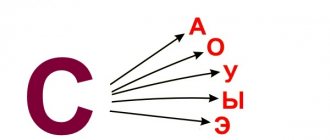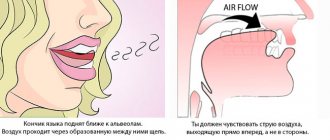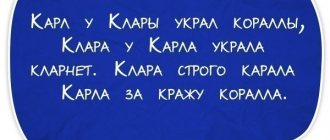Consultation for parents “Automation of sounds at home”
Tamara Papst
Consultation for parents “Automation of sounds at home”
Consultation for parents
By regularly attending speech therapist classes, the sound pronunciation of a preschooler can acquire the character of “desk speech”
when in the speech therapist’s office
(or when asked to repeat correctly) the sounds are clear , but in free speech the child pronounces the same sounds distorted. This indicates that the process of sound pronunciation correction is at the “
automation ” .
The speed of passing this stage depends on the frequency of completing homework aimed at automating the assigned sounds . Ideally, daily automation for at least 5-15 minutes a day.
Automate sound - introduce it into syllables, words, sentences, coherent speech. From a physiological point of view, the stage of sound automation is the consolidation of conditioned reflex speech-motor connections on various speech material. The delivered sound is still very fragile ; the conditioned reflex connection without reinforcement can quickly collapse.
to automating a given sound only when the child pronounces it in isolation completely correctly and clearly with prolonged or repeated repetition, that is, when the teacher-speech therapist “set” sound for the child.
.
In no case should you introduce into syllables and words a sound that is not yet pronounced clearly enough, as this will only lead to the consolidation of incorrect skills and will not improve pronunciation.
Sound automation is carried out according to the principle from easy to difficult, from simple to complex and is carried out in a strict sequence:
• automation of sound in syllables (direct, reverse, with a combination of consonants)
;
• automation of sound in words (at the beginning of the word, middle, end)
;
• automation of sound in sentences;
• automation of sound in pure tongue twisters , tongue twisters and poetry;
• automation of sound in short and then long stories;
• automation of sound in spoken language.
You can move on to new material only if you have mastered the previous one.
1. Stages and techniques for automating delivered sounds in speech .
Automation of sound in syllables.
A syllable is a simpler speech unit compared to a word. In addition, the syllables are meaningless; therefore, the child does not have stereotypes in the pronunciation of words, which facilitates their automation .
Automation of sounds begins with direct open syllables, then continues in reverse and closed syllables. Later, the pronunciation of sounds in syllables with a combination of consonants is practiced. For example, when automating the sound [S] in syllables, we connect the fixed consonant with the vowels [a], [s], [o], [y] first in direct syllables: sa, sy, so, su, then in reverse ones: ac, ys, os, us, then into syllables where the sound is between vowels: asa, asy, aso, asu, ysa, and finally, into syllables with a combination of consonants (those consonant sounds that are not impaired in the child are taken): hundred, hundred, spa, sma, dreams, sko.
Automating sounds in words.
Automation in words is first carried out based on syllables (sa - sad)
.
sound is consolidated , then words in which the sound is at the end and middle of the word.
To automate sound, they use the techniques of reflected repetition, independent naming of words from a picture, and reading of words.
Useful tasks that direct the child to search for words containing a given sound (inventing words with a given sound )
.
Try to introduce creative exercises, games, and move from pronouncing individual words to constructing phrases with them and short statements.
Automating sounds in words is the development of a new skill that requires long-term systematic training. Therefore, for each position of a sound in a word - at the beginning , middle, end - select 20-30 pictures (you can draw a diagram yourself)
.
During one lesson, 10–16 words are given, and each is pronounced 4–5 times, emphasizing the automated sound (it is pronounced longer and exaggerated)
.
At this stage, work is also carried out on complex forms of sound analysis and synthesis , to develop the ability to isolate a sound in a word , determine its place in relation to other sounds (after which sound , before which sound ). This work contributes to the efficiency of the automation . The ability to clearly and quickly determine the sound structure of a word is necessary for the correct and rapid completion of the automation .
Automating sound in sentences.
Automation of sound in sentences is carried out on the basis of practiced words, in the same sequence. At first, sentences with moderate inclusion of sound ; later, automation is carried out on speech material saturated with this sound (each word of the sentence has an automated sound ).
Automation of sound in pure tongue twisters , tongue twisters and poetry.
Children are asked to repeat or memorize phrases, tongue twisters and poems.
2. Games for automating sounds at home .
Learn to play with your child, using any suitable moment for this.
Working on sound , from its production to its use in independent speech, is the development of a new complex skill. And like any skill, it requires effort, time and a certain system in classes, including when doing homework . I offer you several interesting games that can be used, starting from the stage of automating the sound in a word .
"Puzzles"
For this game you will need: 6-7 pictures or toys, the name of which contains an attached sound . Together with your child, name them, highlighting the desired sound . Then describe any of them, the child must guess what it is about and name the desired picture or toy. Repeat the game several times. Now offer your child the role of leader. Your possible mistakes will certainly increase your child’s interest in the game.
“What’s missing?”
You can use the same pictures or toys. Invite your child to carefully look at the pictures again, name them, remember them and close their eyes. At this time, remove one or two pictures. The child, opening his eyes, must say what is missing. Repeat the game several times, changing roles with your child.
"What changed?"
This is one of the variants of the previous game. You can change the places of the pictures, remove them, turn the pictures over, add new ones. The child must tell about all changes.
“What’s extra?”
Select the pictures so that they can be grouped according to different criteria (you can use pictures from the lotto, choosing from them those whose names have the desired sound ). Ask your child to find and name the extra object and explain his choice.
You can combine pictures into groups in different ways. For example, lynx-cow-crow-giraffe-rocket. You can consistently remove the “rocket”
- non-living, then
“crow”
- a bird, then
“cow”
-
a domestic animal .
Invite the child to compare the two remaining pictures (giraffe and lynx)
"Words Around Us"
Ask your child to look carefully around and name all the objects whose names contain the desired sound . Say the words one by one, don’t forget to make mistakes sometimes and give your child the opportunity to notice your mistake and correct it.
Then complicate the game - remember words with a fixed sound on a specific topic: “Name the animals whose names have
the sound [P] ” (zebra, rhinoceros, tiger, panther, kangaroo, giraffe)
or “Name the
“winter”
word with
sound [S] " (snow, snowman, Snow Maiden, bullfinch, snowballs, cold, sleigh)
.
You can play this game anywhere, using any free minute: on the way to kindergarten, in transport, in line. You can play this game with a ball at home
Gradually, imperceptibly for himself, the child begins to correctly pronounce the sound not only in individual words, but also in phrases. The phrase should contain as many words as possible with the desired sound . It is better if the child himself comes up with phrases, first with your help, and then without it. It's even better if you come up with short, funny poems. They are easy to remember, and the child willingly tells them to everyone - family and friends.
The most useful thing for a child is your genuine interest in joint activities and joy for his success. Let the activities bring joy to the baby - the result largely depends on this.
Literature
1. Akimenko V. M. Correction of sound pronunciation in preschoolers : a practical guide. – Rostov n/d: Phoenix, 2015 – 141 p.
2. Vakulenko L. S. Education of correct sound pronunciation in children : Educational manual. –Murmansk: MSPU, 2008. – 116 p.
3. Konovalenko V.V. Individual-subgroup work on correcting sound pronunciation . – M.: GNOM Publishing House, 2021. – 216 p.
4. Polyakova M. A. Self-instruction manual on speech therapy. Universal guide. – M.: T. Dmitrievna, 2015. – 160 p.
5. Khansheva G.V. Speech therapist to the rescue: workshop on speech therapy. — Rostov n/d: Phoenix, 2013 – 109 p.
Elimination of deficiencies in the pronunciation of sounds t, d, n
.Free quota operation: how to get it and what’s changing in 2019 |
How to do IVF for free under compulsory medical insurance: what documents are needed
Detsky sad.Ru >> Electronic library >> Family and children >> Speech development >> M. E. Khvattsev. “Speech therapy work with preschool children” Publishing house “Uchpedgiz”, M., 1961. Given with some abbreviations
OCR Detskiysad.Ru
Normal articulation
.
When pronouncing t
, the position of the lips and teeth depends on the subsequent vowel.
The tongue, with the tip lowered to the lower teeth, is pressed tightly against the upper teeth and alveoli with the front part of the back, the lateral edges are pressed against the upper teeth. With the soft palate raised, an exhaled stream of air quickly and forcefully breaks between the tongue and gum. If the vocal cords tremble, then with the same articulation the sound d
, and when, when the vocal cords tremble, the soft palate is lowered (air passes freely into the nose, the tongue does not leave the gums) - a smooth sound
n
.
Soft d, t, n
are formed by a significant additional raising of the middle part of the back of the tongue, while the explosion with
t
and
d
does not occur immediately and not as sharply as with hard sounds.
Pronunciation deficiencies and frontal methods for eliminating them
Pronunciation problems in these sounds are rare and can be easily corrected. There is insufficient clarity in sounds due to inaccurate articulation and interdental pronunciation d, t
.
Sometimes d
is replaced
t
. The following games are used to develop phonemic awareness. 1. "Duda". Children march to the sounds of the “silver duda” and sing: ay, doo-doo, doo-doo, doo-doo, I play the duda, the silver one: doo-doo-doo-doo-doo, doo-doo-doo-doo -doo-doo-doo-doo. 2. "Train". The carriages rumble: ta-ta-ta-ta-ta-ta. 3. Word game: hammer, bottle, shovel; com-pot, ro-t, hammer-lot, pi-lot, u-daughter, dot-ka, plate, to-pol, to-por, Ta-nya; de-dushka, Da-sha, de-ti, daughter. 4. "Woodpecker". Children imitate the sound of a woodpecker knocking on a tree: A woodpecker is hammering a tree, A woodpecker is hammering an oak tree with its beak: Knock-knock-knock, Knock-knock-knock, He is looking for a worm here. 5. Riddles, nursery rhymes, poems. From the clatter of hooves Dust flies across the field - Who is running? (Horse.)
Long legs ran along the road: Tops, tops, tops, Tops, tops, tops. Little legs ran along the path: Top-top-top, Tot-top-top.
We took a white lump in our hands, We will build a white house. We will pour water on it, Our house will be icy, We put lump after lump - A snowy house will grow.
Individual techniques: 1.) The tip of the tongue develops, as when developing p
(bending upward, pronunciation
t-t-t
. After this, pronounce
ta-to
, etc.).
2) Press the front part of the back of the tongue against the upper lip, use a spatula to carefully push the tongue towards the upper gum and invite the child in this position to blow sharply onto a strip of paper. continuation of the book...





